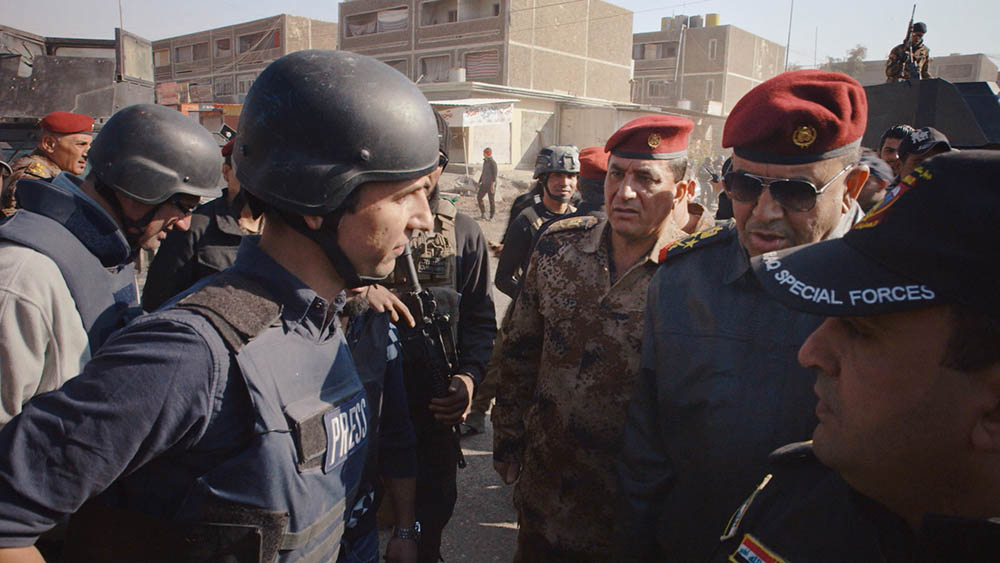Editor’s note: since this piece was first published, Vice News Tonight had a breakout moment with its report on the white-nationalist rally in Virginia, an episode seen by tens of millions of viewers.
The long communal desks lined with laptops stretch almost as far as the eye can see at Vice Media’s cavernous headquarters in Williamsburg. More than 800 people work in the three-story converted warehouse — complete with a bar serving Vice’s own beer, Old Blue Last, and an outdoor garden with a knockout view of Manhattan — churning out content for Vice’s burgeoning array of media ventures: nearly a dozen digital channels covering music, food, sports and more; a 24-hour cable-TV network; and a weekly half-hour documentary series for HBO. But the most intense activity these days is down in the basement, where some 100 Vice News staffers are embarked on one of the most daunting tasks in modern media: trying to reinvent the nightly TV news for the millennial generation.
Vice News Tonight debuted on HBO last October (weeknights at 7:30 p.m. E.T.), and if it hasn’t exactly revolutionized television news, it has thrown some curve balls at the old format. The half-hour show has no anchor, simply a disembodied narrator (two Vice reporters alternate the duty) who introduces the day’s headlines and four or five featured stories.
Those reports typically run four to six minutes — substantially longer than the usual minute-and-a-half haikus that pass for in-depth coverage on the broadcast networks. Vice reporters frequently turn up in remote locales, covering international stories all but ignored by the network news — the plight of Afghan refugees in Sweden, the inflation crisis in Venezuela, the war against separatists in East Ukraine. If nothing else, Vice News Tonight deserves cheers for eschewing that staple of the groveling-for-ratings network evening newscasts. There’s no weather map!
The Vice News Formula: Flexibility
“The evening newscast isn’t obsolete,” says Josh Tyrangiel, the former Time and Bloomberg News editor who joined Vice News in October 2015 to launch the newscast. “But their approach is too rigid. All three network newscasts have an identical format — an anchor and videotape. If they don’t have tape, the anchor has to read the story. If it’s too long for the anchor to read, it never happened.”
Vice News Tonight doesn’t aim to be comprehensive, he says, only more creative in finding ways to “deepen your understanding of the world.” If there’s no interview or video footage, the story might be told with graphics or animation, or simply by a reporter standing in front of the camera and explaining. Tyrangiel says his video inspirations are Sesame Street and Saturday Night Live— two “multiformat playgrounds” that get across their message in a multitude of ways, from monologues and sketches to song parodies and video shorts. “What everybody on this floor understands is that you can’t say there’s no way to tell a story. If the story matters and it’s interesting, find a way.”

Vice News Middle East bureau chief Seb Walker, left, reported from Iraq on the battle to retake Mosul from ISIS (Photo credit: VICE News Tonight on HBO)
The program’s strength so far has been its immersive field pieces from hot spots around the globe — tagging along with Iraqi troops fighting ISIS near the Syrian border, for example, or an 11-minute report on Philippine President Duterte’s anti-drug death squads. But the show has also done good, small-bore reporting on President Trump’s domestic agenda — the impact on Kentucky drug-treatment programs if Obamacare is repealed, or how public-private partnerships, of the sort championed by Trump to rebuild infrastructure, have failed to work in building highways in Virginia.
The broadcast is still finding its footing. Though it opens with a rundown of the day’s headlines and usually covers at least one “today” story at some length, much of the show seems unpegged and featurey — hardly a must-view. The absence of an anchor feels not so much radical as a little distancing (especially with off-screen voices that haven’t yet learned the network-newsreader trick of putting the EMPHASIS on the right WORDS). Though the stories run longer than network news pieces, they still too often seem abbreviated, and the program hasn’t yet done any real investigative reporting.
Watch a Vice News Tonight episode on the impact of a repeal of Obamacare on Kentucky drug-treatment programs (Credit: VICE News Tonight on HBO)
One problem may be the sheer density of breaking news in the months since Trump’s election, which hasn’t played to Vice’s strengths—on-scene reporting from places most reporters don’t go. But as the new President’s war against the media heats up, renegade outlets like Vice may have an important role in digging for the news behind Trump showmanship and tweets.
“Trump has thrown a huge wrinkle into everyone’s coverage,” says Tyrangiel. “I think it’s pretty clear that access to the White House is not coming. It’s not coming for everybody. A lot of people’s assumptions about how you cover an administration are predicated on having people in the building. And I’m not sure there’s much value in that any more.”
Though ratings have not been released, Tyrangiel says the audience thus far has exceeded expectations. He promises “another jolt of innovation” in the next couple of months, as well as more expansion: the Washington bureau will soon double in size, and a new bureau just opened in Beirut (joining existing Vice News bureaus in Los Angeles, San Francisco and London).

Josh Tyrangiel, executive vice president content, news at Vice Media (Photo credit: Madeleine Peters/VICE )
Brooklyn as Home Base
All of which is being directed from the hipster reaches of Brooklyn, where Vice founder Shane Smith moved his media company in 1999 after launching it in Montreal with a print magazine in 1994. Tyrangiel, who rides a Citibike across the Williamsburg Bridge to the office each morning from his East Village apartment, sees the neighborhood as a fitting reflection of Vice’s ethos: “authentic, rough, valuing new stuff, enjoying being cool.”
And keeping a little distance from the mainstream media scrum just across the East River. “You go up on the roof and look at Manhattan, and it’s just right there. And yet it feels very far away. We’re competitive with everybody else in media. But because we’re not in the same zone, we don’t feel it as much. And we don’t talk about what everybody else is doing as much. We’re very focused on ourselves.”
Now the challenge is to get everybody else focused on Vice, five nights a week. With that and a couple of newsmaking scoops, the outsiders may really change the face of TV news. They’ve already got the beer to celebrate.